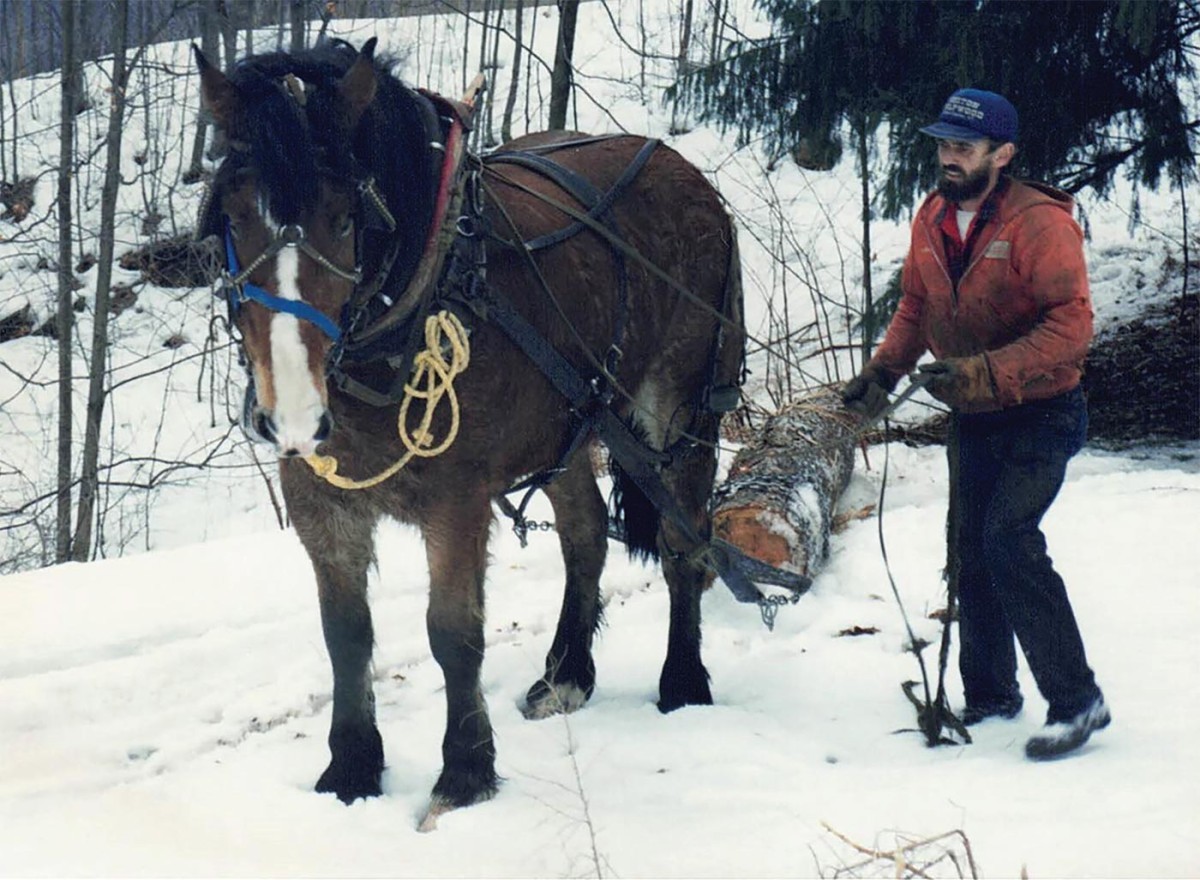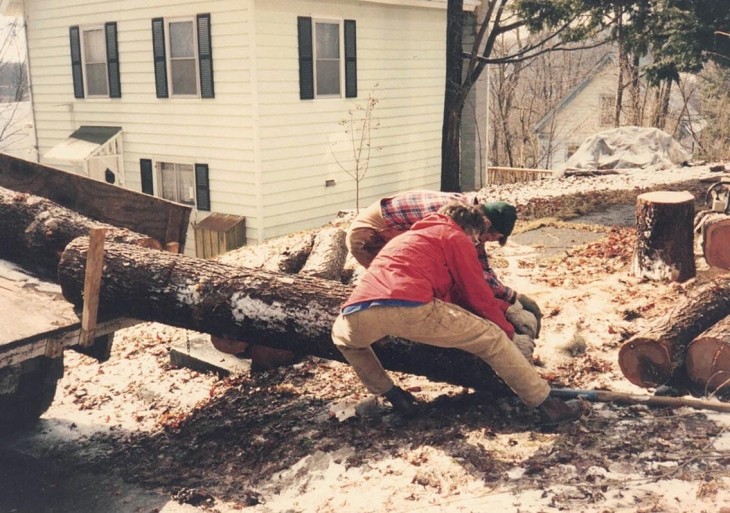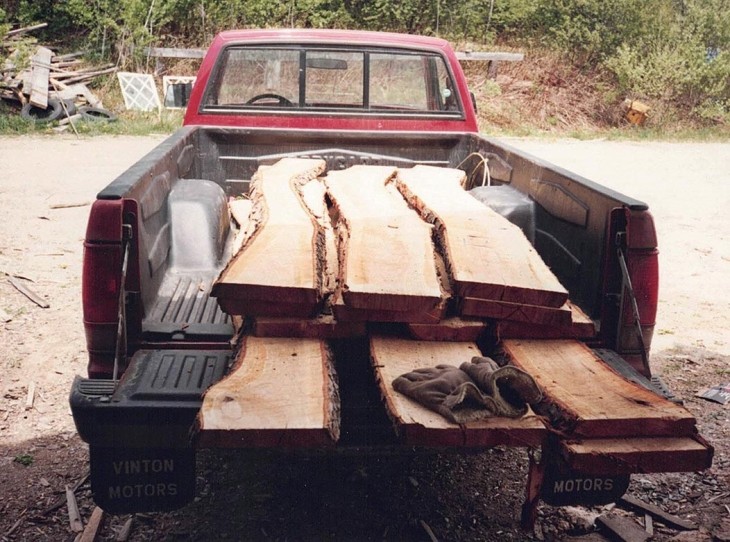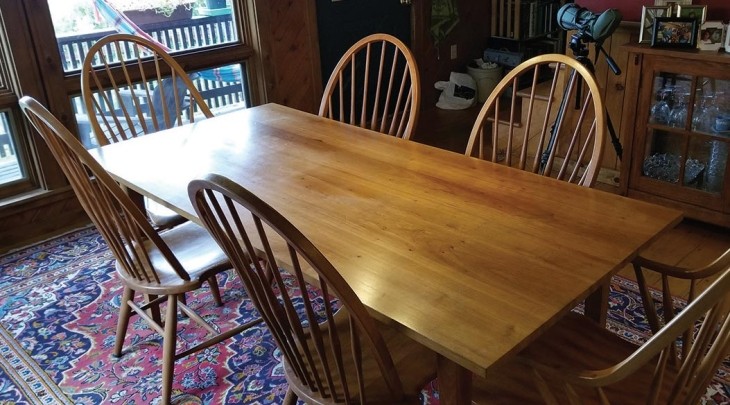
A hundred years ago the black cherry tree in the gully behind our house on Cliff Street sprouted in a hillside pasture. It hasn’t moved, but the village has crept up the hill and the neighborhood has changed.
It has two trunks, one much thicker than the other. Beside the tree stands a cast-iron cook-stove, growing rust and settling every season a little deeper in the soil. The tree keeps doing what it knows how to do. Dark, glossy leaves in spring, fronds covered with delicate white flowers; drooping clusters of small, fat-pitted cherries for the birds late in summer; stubby fingers gripping the cold winter air.
Small piles of sawdust tell me carpenter ants have found the tree’s red roots. They tunnel up through the early years, turning heartwood green. They cluster like dried currants when my chainsaw finds their corridors.
I cut with a table in mind. I want a surface lovely, old, and familiar to share with friends; so I come to the history in our backyard. The neighbors watch uneasily from their windows. Not much logging goes on here.
A sharp crack – my saw stops insisting. The kerf widens, I step back. The slow, accumulated years of gravity are all spent at once – a groan, a shudder, suddenly the tree roars toward its shadow on the ground. Roots cringe under my feet; the hinge bristles with splinters. The woods edge gapes like a mouth missing a tooth.
Jim Abare has been thinning pine nearby in Hubbard Park. They hire him because the woods seem almost untouched when he and his horse are done. I track him down and ask if he would come help. His horse clops up our street, chains jingling – sounds not heard here for years.
Forty years ago, my father and I worked our woods in the Northeast Kingdom with a team. Now, Jim and I stand on a shelf of lawn above the gully, next to the Norway spruce Mr. Edson planted for his sons. We discuss how to twitch the logs out: up a gradual slope to Susan Abdo’s land, around a maple tree, back across frozen lawn and patch of garden, past the plum tree on its terrace, then sharp left up a bank between fir and honeysuckle, past the woodpile, out to the fire hydrant on the front lawn where the road cut makes a perfect landing.
He says, “We had a stove like that when I was growing up.”
By now the neighbors have come out to watch. They must have phoned each other. They line up on the road above the garden for the spectacle.
Jim keeps talking to his horse, soothing as he backs her to the log, hitches chain to whiffletree.
“Okay girl,” a slap of reins and she explodes against its weight, churning through frozen loam, uphill. Jim talks, long leather reins in hand, and dances the whole way up, back and forth across the writhing log. He does it six times.
The horse stands lathered by the road; Jim quietly unhooks the chain.
When all the logs are up I ask how much; he says, “Fifteen dollars would be fair.” I give him thirty.
A week later, Sandy LaPerle backs his truck to the bank and we slide the logs on. He takes them to Darryl Arsenault in East Montpelier, who cuts them into six-quarter slabs. This is the year Darryl will close up his mill and move to Arizona. We drive out to get the planks, slide them – damp, covered with fine sawdust, smelling like my childhood – into our tiny red Toyota pickup. We stack them, stickered and weighted against the curl of drying in the attic over the garage.
Two summers later we haul the dried planks to Bruce Gratz’s woodworking shop. He says he likes to use native wood, but could have gotten Pennsylvania cherry for less than the cost of working this to size.
The table is darkening now to its own deep red in our dining room. A second small companion table seems to echo the second cherry stem and sits against the south wall, underneath the window. There was wood enough for cabinets, and trim for bookshelves in the study. Bruce made them all.
Sometimes when I sit here over coffee, I imagine a meal for all of us: a potluck table-dedication. The neighbors all troop in and set their dishes down on trivets that protect the glowing wood that will eventually have its own tale of nicks and scratches.
They are skeptical at first. I introduce them to Jim, whose horse is tied to the hydrangea in the yard. Sandy testifies, peavey leaning by the door, telling how we slid the logs inside his truck by hand. Darryl is tanned from Arizona sun, but swears he did the sawing. Bruce shows how he pegged the corners.
I imagine we all sit down together eating and talking; someone says the food tastes better this way. Everyone agrees.
This is like sap we drank from galvanized pails – the unconscious comfort of knowing what we thought we knew about each other and our land.
In fact, the dining room is peaceful. I sit by myself. Just a ribbon of orange divides the darkness from the hills. It wasn’t that long ago, I think, when it was ordinary to enjoy things made together with our many skills, from materials at hand.




